Customer spotlight: Francesco Simone Ruggeri
Please can you introduce yourself, your professional background, and how you came to be involved in nano-analysis at the interface between organic and physical chemistry?
I am currently Associate Professor leading the Nanoscale Microscopy and Spectroscopy group at Wageningen University (WUR) in the Netherlands. I was first appointed as Assistant Professor in December 2020. To pursue my research at WUR, I received a substantial start-up grant from the Dutch Ministry of Education under the Sector Plan to strengthen research in physics and chemistry in the Netherlands; I also received support from key industrial partners (ASML, Park Systems, Bruker Nano) and the Organic and Physical Chemistry Departments to establish a nano-analytical facility, NanoFACT.
Before my appointment at WUR, I completed two independent Junior Research Fellowships at the Department of Chemistry at the University of Cambridge and at the Darwin College (UK), where I also received a Master of Arts. I hold a PhD in biophysics, which I obtained in 2015 at the École Polytechnique Fédérale de Lausanne (EPFL) in Switzerland.
During my PhD at the EPFL, my main accomplishment was the first implementation of infrared nanospectroscopy in biology with the aim of revealing the properties of individual amyloid species with nanoscale chemical and mechanical resolution (Nature Communications, 2015; Angewandte, 2015). I was then awarded the Swiss Early and Advance Postdoc Mobility Fellowships to pursue my research at the University of Cambridge in the UK. In Cambridge, the impact of my results also enabled me to secure an independent Junior Research Fellowship at Darwin College. The main achievements of my original research programme in Cambridge were the development of physical and analytical approaches, combining spectroscopy with atomic force microscopy and microfluidic devices, to study biological systems that are challenging to access using conventional bulk biophysical methods (Nature Nanotechnology, 2020; ACS Nano, 2020; Nature Comm., 2019; Nucleic Acid Research, 2019; Nature Comm., 2018; PNAS, 2018; Nature Chemistry, 2018; Cell, 2018; Nature Comm., 2017). Furthermore, as a major advance in this field, I demonstrated the possibility to study the chemical properties of biological samples at the nanoscale in native liquid environment (ACS Nano, 2018) and at the single molecule scale (Nature Comm., 2020).
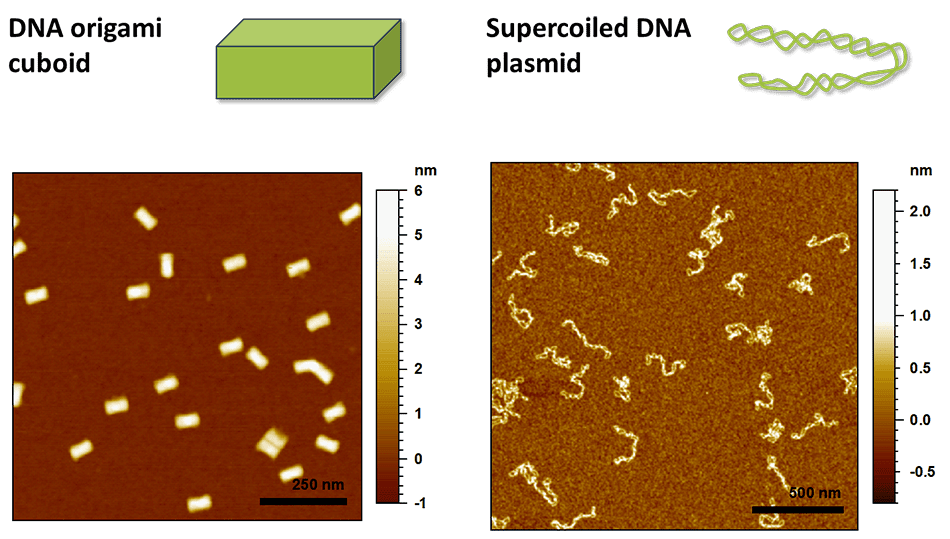
Above. AFM single-molecule images of DNA origami cuboids and supercoiled plasmid DNA
Overall, my expertise has already led to the publication of more than 80 peer-reviewed scientific articles, more than a third as first or corresponding author. More than 30 of these works were published in Nature, PNAS, Cell, Angewandte, ACS Nano or Science series journals.
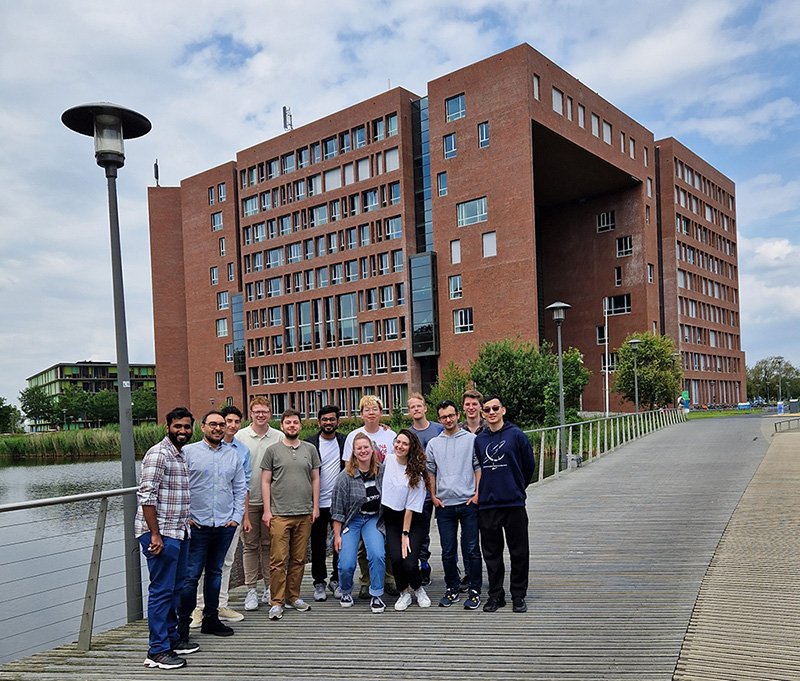
Above. Members of the Nanoscale Microscopy and Spectroscopy group at Wageningen University (WUR).
What are your current projects?
My current work lies at the interface between the chair groups of organic chemistry, physical chemistry and soft matter. I lead a dynamic group of several talented graduate and post-graduate students with the aim of developing and applying nano-analytical imaging and spectroscopic technologies to open a new research window of observation with nanoscale sensitivity in chemistry, biology and materials science. In particular our focus is on:
- Pushing the limits of single-molecule nano-analytical chemistry.
I aim at providing a leading contribution to the field of nano-analytical chemistry by developing transformative imaging and spectroscopic technologies with single-molecule morphological, mechanical and chemical resolution (Nature Communications, 2021). To reach this objective, I combine scanning probe microscopy, spectroscopic methods and microfluidics technologies (Science Advances, 2023).
- Unraveling biomolecule properties in food, health and disease.
My work focuses on applying the unique combination of the technologies I develop to study biomolecule properties in food, supramolecular assembly of organic molecules and biomolecular assembly of protein along with its role in cell function/malfunction during the onset and progression of pathological ageing and dementia (Communications Biology, 2024; PNAS, 2023; Nature Communications 2021).
- Designing and characterizing material properties.
Another aspect of my research is exploiting the singular nano-chemical vision developed in my laboratory to help design and characterize properties and functionality of polymeric materials, such as antifouling coatings, protein-based functional materials such as bioplastics and solid interfaces such as perovskite solar cells (Journal of Polymer Science, 2024; Talanta, 2024; Science, 2021).
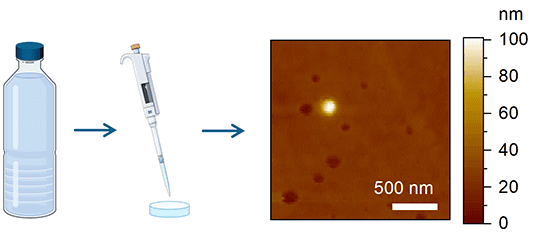
Above. Single particle micro- and nano-plastics analysis
What is the innovation of your research and what is the most significant or exciting part to you?
During my career, I had the successful intuition that the development of nano-imaging and chemical methods could have significant impact in science, and I was one of the first (if not the first) researchers worldwide to push the development and application of infrared nanospectroscopy in biology.
One of my key innovations was demonstrating for the first time the use of nano-mechanical mapping and infrared nanospectroscopy (AFM-IR) in unravelling the properties of biological samples and biomolecules at the nanoscale. I also recently established that AFM-IR is capable of acquiring the chemical fingerprint and secondary structure of protein in native liquid environments and at the single-molecule scale, which is a major advance in our field of microscopy and spectroscopy.
In parallel, I applied nano-analytical methods to the study of biomolecular systems that are challenging to access using conventional bulk biophysical methods. Initially, I first focused on studying protein self-assembly in disease, demonstrating with several impactful publications that my approaches could deliver unique molecular insights on the mechanisms leading to Ataxia, Parkinson’s, Alzheimer’s and Amyotrophic Lateral Sclerosis. Then, I extended my approach to biomolecular processes at the base of cellular function and life, as well as to the characterization of functional materials. These results have brought visibility to my research and recognition as a world-renowned expert in single-molecule nano-imaging, vibrational spectroscopy and nano-chemical analysis in protein science.
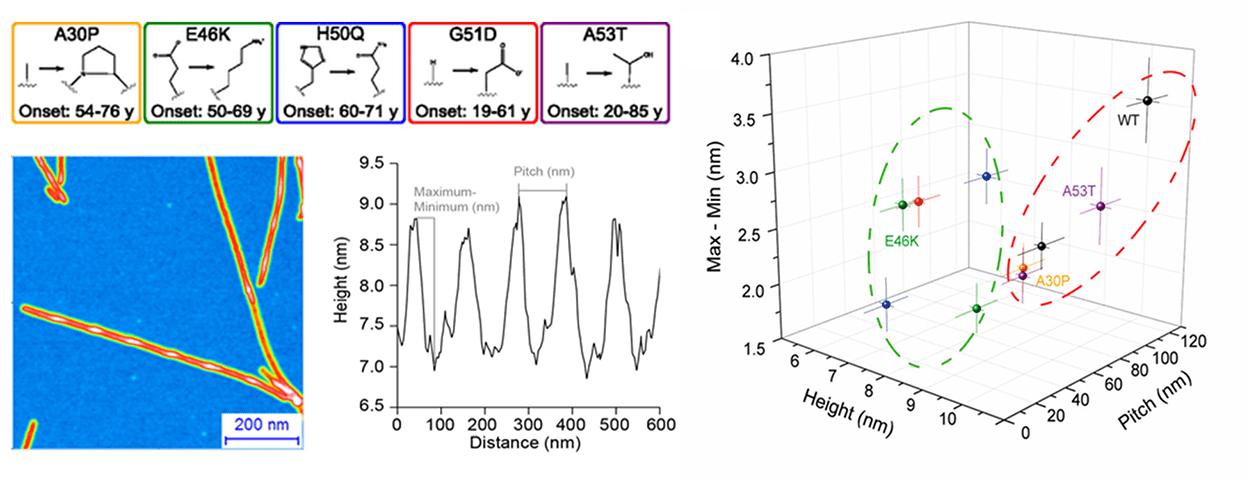
Above. Mutations associated to onset of Parkinson’s disease and to different amyloid species formed
I am particularly excited to further apply my expertise in nano-analytical chemistry to help our society solve key problems, with the ultimate goals of leveraging our understanding of Nature and raising quality of life. This includes improving food quality and tackling neurodegeneration and other health issues of ageing populations with the aim of giving true possibilities of life enhancement for patients. My research also aims to contribute to the development of renewable and functional materials allowing our society to embrace a sustainable, circular economy. Associating the study of fundamental molecular phenomena through experiments to their possible exploitations in real life and contributing to solve crucial problems in society have become a passion and are among the main drivers of my interest in research.
What role does MountainsSPIP® software play in your research?
MountainsSPIP® is fundamental for our laboratory for pre-processing and quantitatively analyzing most of our research outputs ranging from: conventional and confocal imaging techniques, nano-imaging and nano-mechanical analysis via atomic force spectroscopy and nano-chemical analysis by infrared nanospectroscopy.
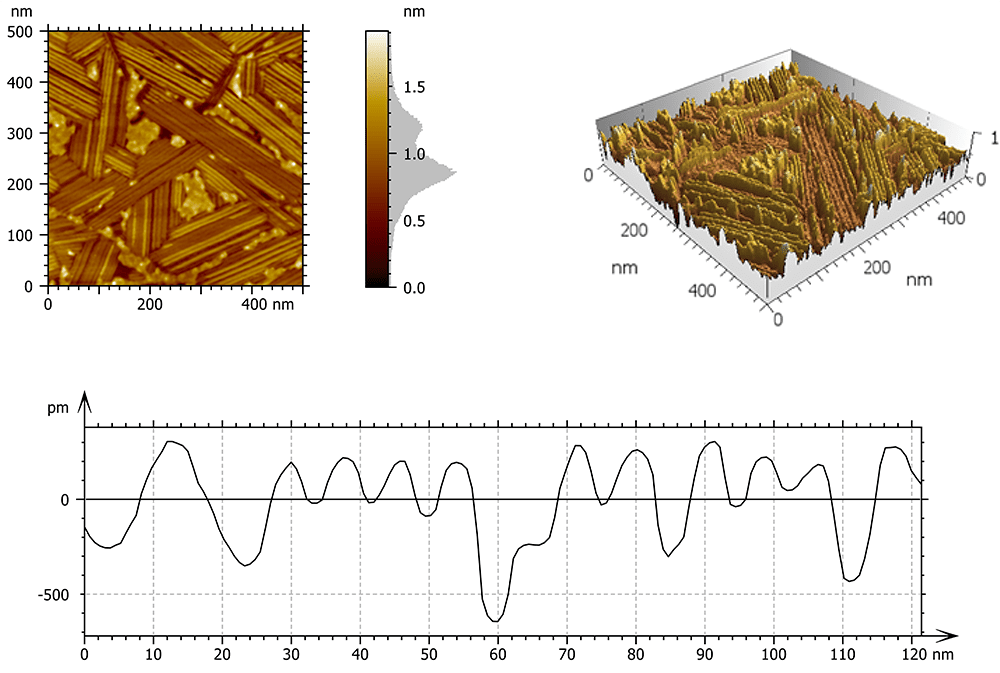
Above. Analysis of self-assembled polymers on a surface using MountainsSPIP® analysis software.
Where can readers find more information?
More information can be found on the following social media and websites:
- linkedin.com/in/fsr
- https://x.com/RuggeriLab
- https://research.wur.nl/en/persons/francesco-s-ruggeri/
- https://www.nanofact.nl/.
Recent articles
- https://www.nature.com/articles/s42003-024-05858-7
- https://www.science.org/doi/10.1126/sciadv.abq3151
- https://www.nature.com/articles/s41467-020-20782-0
- https://onlinelibrary.wiley.com/doi/10.1002/smtd.202001002
- https://www.nature.com/articles/s41467-020-16728-1
- https://www.sciencedirect.com/science/article/pii/S0039914023007166?via%3Dihub
- https://www.sciencedirect.com/science/article/pii/S0165993622003028?via%3Dihub
- https://pubs.acs.org/doi/10.1021/acsnano.0c07570
- https://www.science.org/doi/10.1126/sciadv.abq3151
Full list at https://research.wur.nl/en/persons/francesco-s-ruggeri/publications/.
